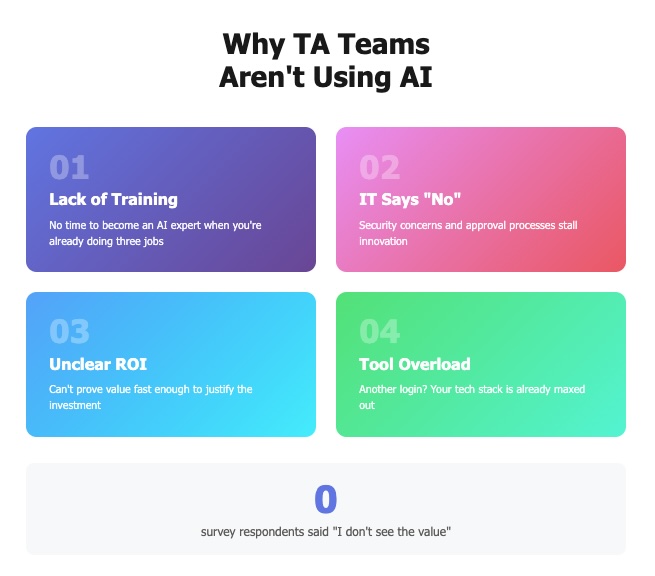- The Real Reasons TA Teams Are Not Using AI (Even When They Want To) - November 12, 2025
- Why “Insight” Might Be the Most Underrated AI Superpower in Hiring - November 11, 2025
- Job Description Tracking Doesn’t Have to Be a Nightmare - November 10, 2025
AI isn’t the problem. It’s the pile of tools, the red tape, and the fact that nobody wants to feel dumb using something “new.”
We asked TA and HR folks (in my “What’s Your AI Animal” survey) what’s stopping them from using AI more effectively. And guess what? Not one person said, “I don’t see the value.”

The blockers are real-world, very human things like:
- Lack of training or knowledge
- Security or IT restrictions
- Unclear ROI
- Already juggling too many tools
The Training Trap
This one was the most common and most relatable. You’re already doing the job of three people. When are you supposed to carve out time to become an AI expert?
Plus, a lot of AI tools don’t come with a real user manual. They expect you to just “figure it out.” That’s a nonstarter for busy recruiters and HR teams who are already learning new systems constantly.
IT Says “No”
Even if you’re ready to try AI, your company’s IT gatekeepers might not be. Security concerns are real—especially with sensitive candidate data in play. But sometimes “security” is just code for, “We haven’t figured out how to approve this yet.”
And when you can’t get tools cleared, innovation stalls. This creates a workflow problem. That’s a big reason many teams are still not using AI, even when it could help.
ROI Is Still a Question Mark
AI vendors love to say their tools save time and money. But how can we show the receipts? HR teams are being asked to do more with less, and they can’t gamble on software that might pay off “eventually.” If the benefit isn’t measurable fast, it goes to the back of the line.
And let’s be honest—some AI tools just add more steps. This is another reason people are not using AI in their day-to-day workflows.
Too Many Tools, Not Enough Hands
If you’ve ever opened a new app just to stare at it for five minutes before closing the tab, you get it. The TA tech stack is already bloated. Add one more login, and you might snap.
AI only works if it integrates with your flow—not fights against it. It’s got to make things easier, not just different. Otherwise, it’s just another tool that ends up not being used at all.
So What Do We Do About Not Using AI?
Here’s the good news: you’re not behind. You’re not lazy. You’re not resistant to change.
You just need:
- Training that speaks your language
- AI that fits into the tools you already use
- Proof it’ll work before you buy in
- And a green light from IT that doesn’t take six months
And that’s exactly where smart AI platforms (like Ongig) come in.
Why I Wrote This
We asked TA pros what’s getting in their way with AI—and the answers were way more honest than we expected. If you’re feeling blocked by lack of training, tech overload, or unclear ROI, you’re not alone. Ongig was built to remove those blockers, with training, integration, and support that actually makes sense.
Request a demo to see how we help teams like yours put AI to work—without the headaches.
FAQs
What’s the #1 barrier to using AI in HR?
Lack of training or knowledge came up most often in our survey.
Is AI safe to use for candidate data?
It depends on the tool. Look for platforms with strong data security policies and SOC 2 compliance.
How do I get IT approval to use AI?
Start early, share clear use cases, and pick tools with proven track records. Ongig works with most IT teams out of the box.
Will AI replace recruiters?
Nope. It helps you work smarter by cutting busywork—so you can focus on people, not processes.
How do I know if AI is worth the investment?
Ask for real data. Ongig clients report faster hiring and better job description engagement.
